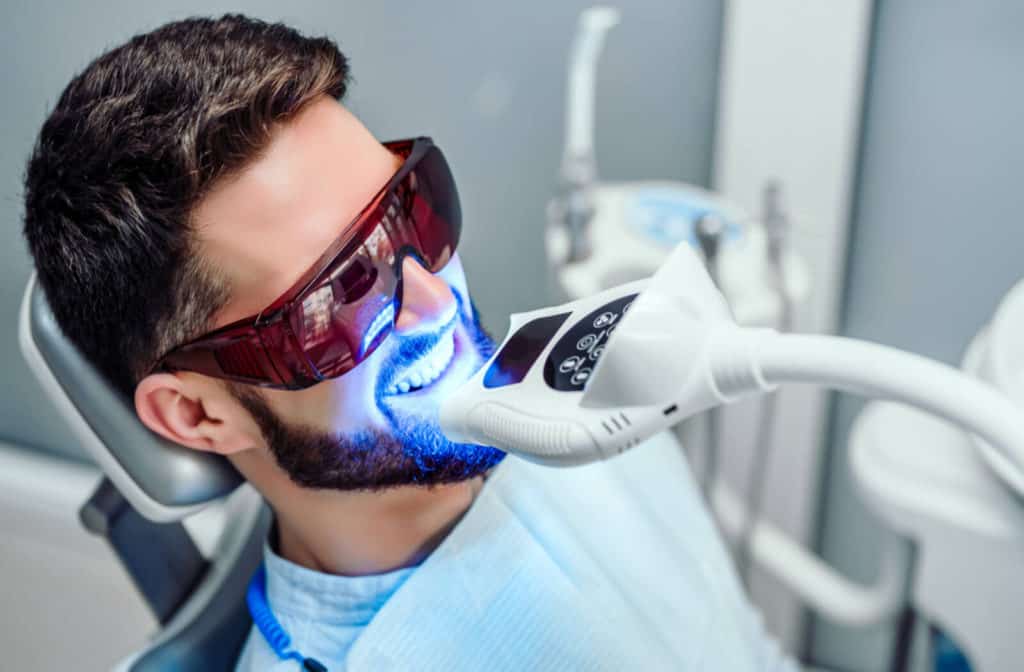How Often Can You Get Your Teeth Whitened?
Maintaining and enhancing your smile can include many aspects of dental health. These include restorative dentistry and cosmetic dentistry.
Whitening your teeth can do wonders for your smile. But what does teeth whitening entail, and how often should you get your teeth whitened? Read on to find out more.
What is Teeth Whitening?
Teeth whitening is a well-known cosmetic procedure that uses whitening agents to remove yellow stains from teeth and brighten their appearance. This process can make your teeth appear whiter, even if they are not naturally white.
Teeth can become stained and discoloured by the foods and drinks we consume, for example:
- Tea and coffee
- Red wine
- Soda
- Berries
- Sauces
There are 2 options for teeth whitening:
In-Office Whitening
Also known as chairside whitening, it can get your teeth whiter faster. These peroxide-based whitening solutions are higher in strength than at-home whitening kits and capable of altering the colour of teeth.
The process usually involves protecting the gums and applying the solution to your teeth. The whitening solution is then activated with a UV light. Single appointments can produce effective results.
At-Home Whitening
Many at-home whitening treatment options available today are limited to surface stain removal. Their effects do not last as long as in-office treatments, but they are cheaper. At-home whitening products include:
- Whitening strips and gels: Strips and gels are peroxide-based and applied directly to the teeth.
- Whitening toothpaste: These contain abrasives to remove surface stains, chemicals, or polishing agents. Whitening kinds of toothpaste that contain peroxide are not as effective if not left on for long enough.
- Whitening trays: These mouth guard-like trays are filled with a peroxide whitening solution and placed on the teeth. You can get bleaching trays over-the-counter or custom-made from your dentist.
- Whitening pens: These contain whitening gel applied directly for spot stain removal. They offer minimal and short-lived results.
The Side Effects of Teeth Whitening
Teeth whitening is safe to use under the supervision and care of your dentist. At-home teeth whitening is also safe as long as you use them appropriately.
At the same time, there are some possible side effects, but these are usually temporary. Possible side effects include:
- Tooth sensitivity: This is usually temporary.
- Irritation and burns to soft tissues: This can happen with at-home whitening trays that are not custom fitted. For chairside-whitening, they protect the gums before treatment.
- Inflamed or bleeding gums: This can result from a reaction to the whitening ingredients. Call or visit your dentist immediately if this happens.
- Whitening of gums: Bleaching the gums can lead to some colour loss, but this is temporary.
- Damage to tooth enamel: Any abrasive or bleaching solution in whiteners can cause thinning of the tooth enamel, if used excessively.
- Pain: Tooth pain can occur if the whitening solution seeps into a cavity or cracked tooth. Dental checkups are necessary to ensure good oral health before teeth whitening.
Frequency for Teeth Whitening
There is no specific frequency for how often you should get your teeth whitened. It mainly depends on the amount of teeth staining, diet, lifestyle, and your desired level of whiteness.
It also depends on whether you prefer in-office or at-home whitening. At-home whitening lasts for a few months and may need more frequent procedures. In-office whitening can last for a few years, between 1 and 3.
After whitening, it is imperative to maintain results to avoid repeating the process more often. Although, individuals who consume foods with staining agents and smokers may require more frequent teeth whitening than others. For more effective results, in-office treatments with at-home touch-ups can maintain whiter teeth for longer.
For Longer Lasting Results
To maintain a whiter smile and ensure longer-lasting effects of teeth whitening between treatments, you can follow some simple tips:
- Quit smoking: Smoking can stain the teeth and make them appear yellow.
- Limit certain foods and drinks: These are not bad for you but can discolour your teeth.
- Drink plenty of water: Especially while consuming foods and drinks that can stain your teeth.
- Rinse your mouth: Rinsing the mouth with water after drinking coffee or wine.
- Use a straw: Drinking artificially coloured liquids through a straw can prevent staining.
- Brush your teeth: Brushing after every meal can avoid unnecessary staining unless it is acidic food. If you do not have a toothbrush handy, mouthwash can work too.
- Schedule regular exams and cleanings with your dentist.
Boost Your Smile with Teeth Whitening
There are ways to whiten teeth safely through in-office treatments or at-home applications by following proper directions and instructions. In addition to teeth whitening, maintaining healthy teeth and a bright smile includes daily brushing, flossing, and regular dental checkups.
If you are interested in whitening your teeth or have questions about the process, contact South Ancaster Family Dental to schedule an appointment.

